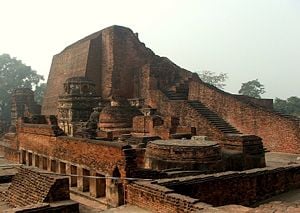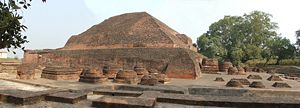Nalanda
Nālānda (Sanskrit: meaning giver of knowledge) is the name of an ancient monastic-universities of India that was renowned as a center of learning and for its large library of sacred texts. Established in 427 C.E., Nalanda flourished for several hundred years until its destruction in 1197 C.E. at the hands of Muslim invaders.[1] The ruins of the monastery are located about 55 miles south east of the modern Indian city of Patna (25.135766 N 85.444923 E).
Nalanda has been called "one of the first great universities in recorded history."[2] In ancient times, Nalanda was particularly known as a center of Buddhist learning and many of its Buddhist teachings were transmitted to other parts of Asia including China and Tibet, where Buddhism continueed to flourish after its wane in India.
Etymology
The origin of the name Nalanda is disputed. It may derivey from nalam, lotus, a symbol of knowledge and da, to give).[3] The Chinese pilgrim-monk Xuanzang[4] gives several explanations of the name Nālandā. One is that it was named after the Naga who lived in a tank in the middle of the mango grove. Another - and accepted by him - is that the Bodhisattva once had his capital here and gave "alms without intermission," hence the name.
Nalanda in the time of the Buddha (500 B.C.E.)
The Buddha is mentioned as having several times stayed at Nalanda. When he visited Nalanda he would usually reside in Pāvārika's mango grove, and while there he had discussions with Upāli-Gahapati and Dīghatapassī[5], with Kevatta[6], and also several conversations with Asibandhakaputta[7].
The Buddha visited Nālandā during his last tour through Magadha, and it was there that Sariputta uttered his "lion's roar," affirming his faith in the Buddha, shortly before his death[8]. The road from Rājagaha to Nālandā passed through Ambalatthikā[9], and from Nālandā it went on to Pātaligāma[10]. Between Rājagaha and Nālandā was situated the Bahuputta cetiya[11].
According to the Kevatta Sutta[12], in the Buddha's time Nālandā was already an influential and prosperous town, thickly populated, though it was not till later that it became the centre of learning for which it afterwards became famous. There is a record in the Samyutta Nikaya,[13] of the town having been the victim of a severe famine during the Buddha's time. Sāriputta, the right hand disciple of the Buddha, was born and died in Nālandā.[1]
Nālandā was the residence of Sonnadinnā.[14] Mahavira is several times mentioned as staying at Nālandā, which was evidently a centre of activity of the Jains. Mahavira is believed to have attained Moksha at Pavapuri, which is located in Nalanda (also according to one sect of Jainism he was born in the nearby village called Kundalpur).
King Ashoka (250 B.C.E.) is said to have built a temple there[1]. According to Tibetan sources, Nagarjuna taught there[15].
Historical studies indicate that the University of Nalanda was established 450 C.E. under the patronage of the Gupta emperors, notably Kumaragupta.[1]
Description of Nalanda University
Nalanda was one of the world's first residential universities, i.e., it had dormitories for students. In its heyday it accommodated over 10,000 students and 2,000 teachers. The university was considered an architectural masterpiece, and was marked by a lofty wall and one gate. Nalanda had eight separate compounds and ten temples, along with many other meditation halls and classrooms. On the grounds were lakes and parks. The library was located in a nine storied building where meticulous copies of texts were produced. The subjects taught at Nalanda University covered every field of learning, and it attracted pupils and scholars from Korea, Japan, China, Tibet, Indonesia, Persia and Turkey.[2] The Tang Dynasty Chinese pilgrim Xuanzang left detailed accounts of the university in the 7th century.
Influence on Buddhism
A vast amount of what is considered to be Tibetan Buddhism (Vajrayana) actually stems from the late (9th-12th century) Nalanda teachers and traditions. Other forms of Buddhism, like the Mahayana followed in Vietnam, China, Korea and Japan, found their genesis within the walls of the ancient university.
Also Theravada Buddhism was taught at Nalanda University. But the teachings of Theravada were not developed further in Nalanda, as Nalanda was not a strong center of Theravada.
Decline and end
Due to the disappearance of Buddhism from India during the 12th century, the university was in decline. In 1193, the Nalanda University suffered a final blow after the complex was sacked by Muslim armies[16] under Bakhtiyar Khilji; this event is seen as a milestone in the decline of Buddhism in India. It is said that Khilji asked if there was a copy of the Koran at Nalanda before he sacked it. When the Tibetan translator Chag Lotsawa visited them in 1235, he found them damaged and looted, but still functioning with a small number of monks. Ahir blames the destruction of the temples, monasteries, centers of learning at Nalanda and northern India for the demise of ancient Indian scientific thought in mathematics, astronomy, alchemy, and anatomy.[17] Ling and Scott, however, point out that centres of learning were already declining, before the presence of Muslims.[16] Fortified Sena dynasty monasteries along the main route of the invasion were destroyed, and being off the main route both Nalanda and Bodh Gaya survived. Many institutions off the main route such as the Jagaddala Monastery in northern Bengal were untouched and flourishing.
Ruins
A number of ruined structures survive. Nearby is the Surya Mandir, a Hindu temple. The known and excavated ruins extend over an area of about 150,000 square metres, although if Xuanzang's account of Nalanda's extent is correlated with present excavations, almost 90% of it remains unexcavated.
Nālandā is no longer inhabited. Today the nearest habitation is a village called Bargaon.
In 1951, a modern centre for Pali (Theravadin) Buddhist studies was founded nearby by Bhikshu Jagdish Kashyap, the Nava Nalanda Mahavihara. Presently, this institute is pursuing an ambitious program of satellite imaging of the entire region.
The Nalanda Museum contains a number of manuscripts, and shows many examples of the items that have been excavated.
Plans for revival
- On December 9, 2006, the New York Times detailed a plan in the works to spend $1 billion to revive Nalanda University near the ancient site. A consortium led by Singapore and including China, India, Japan and other nations will attempt to raise $500 million to build a new university and another $500 million to develop necessary infrastructure.[2]
- On May 28, 2007, Merinews reported that the revived university's enrollment will be 1,137 in its first year, and 4,530 by the fifth. In the 'second phase', enrolment will reach 5,812. [18]
- On June 12, 2007, News Post India reported that the Japanese diplomat Noro Motoyasu said that "Japan will fund the setting up an international university in Nalanda in Bihar". The report goes on to say that "The proposed university will be fully residential, like the ancient seat of learning at Nalanda. In the first phase of the project, seven schools with 46 foreign faculty members and over 400 Indian academics would come up." ... "The university will impart courses in science, philosophy and spiritualism along with other subjects. A renowned international scholar will be its chancellor."[19]
- On August 15, 2007, The Times of India reported that Dr A.P.J. Abdul Kalam has accepted the offer to join the revived Nalanda International University sometime in September 2007."[20]
Notes
- ↑ 1.0 1.1 1.2 1.3 Altekar, Anant Sadashiv (1965). Education in Ancient India, Sixth, Varanasi: Nand Kishore & Bros.
- ↑ 2.0 2.1 2.2 "Really Old School," Garten, Jeffrey E. New York Times, December 9, 2006.
- ↑ Tharoor, Shashi. Reconstructing Nalanda. The Hindu. Retrieved February 5, 2007.
- ↑ Beal: op. cit., ii.167f
- ↑ S.ii.110; M.i.376ff.
- ↑ D.i.211ff.
- ↑ S. ii. 311 23
- ↑ D.ii.81f.; iii.99ff.; S.v.159ff.
- ↑ D.ii.81; Vin.ii.287
- ↑ D.ii.84
- ↑ S.ii.220
- ↑ Digha Nikaya.i.211
- ↑ S.iv.322
- ↑ VvA.144
- ↑ Hopkins, Jeffrey (1996). Meditation on Emptiness, Wisdom Publications.
- ↑ 16.0 16.1 Scott, David (May, 1995). Buddhism and Islam: Past to Present Encounters and Interfaith Lessons. Numen 42 (2).
- ↑ D. C. Ahir, Buddhism Declined in India: How and Why?, Delhi: B. R. Publishing, 2005.
- ↑ "Nalanda Int’l University: A commendable initiative", K.jha, Ashok, Merinews, May 28, 2007.
- ↑ "Japan Eager To Invest In Nalanda University," News Post India, June 12, 2007[1].
- ↑ "Kalam to join Nalanda University soon," The Times of India, August 15, 2007[2].
ReferencesISBN links support NWE through referral fees
- Ahir, D.C. Buddhism Declined in India: How and Why? Delhi: B. R. Publishing, 2005.
- Chauley, G. C. "Art and Architecture of Nalanda" Sandeep Prakashan, 2002. ISBN 978-8175741218
- Hopkins, Jeffrey Meditation on Emptiness. Wisdom Publications, 1996. ISBN 978-0861711109
- Kumar, Jainendra. "Land Use Analysis: A Case Study of Nalanda District, Bihar" Stosius Inc/Advent Books Division, 1986. ISBN 978-8121000635
- Paul, Debjani. "Art of Nalanda" South Asia Books, 1995. ISBN 978-8121506281
- Misra, Bhaskaranatha. "Nalanda" B.R. Pub. Corp, 1998. ISBN 978-8176460163
- Mullick, C. C. "Nalanda Sculptures: Their Bearing on Indonesian Sculptures" South Asia Books, 1991. ISBN 978-8185268101
- Nath, B. "Nalanda Murals" Cosmo, 2003. ISBN 978-8170201182
- Sastri, Hiranand. "Nalanda and its epigraphic material" Indian Book Centre, 1986. ISBN 978-8170300137
- Stewart, Mary L. "Nalanda Mahavihara" British Archaeological Reports, 1989. ISBN 978-0860546740
Credits
New World Encyclopedia writers and editors rewrote and completed the Wikipedia article in accordance with New World Encyclopedia standards. This article abides by terms of the Creative Commons CC-by-sa 3.0 License (CC-by-sa), which may be used and disseminated with proper attribution. Credit is due under the terms of this license that can reference both the New World Encyclopedia contributors and the selfless volunteer contributors of the Wikimedia Foundation. To cite this article click here for a list of acceptable citing formats.The history of earlier contributions by wikipedians is accessible to researchers here:
The history of this article since it was imported to New World Encyclopedia:
Note: Some restrictions may apply to use of individual images which are separately licensed.


